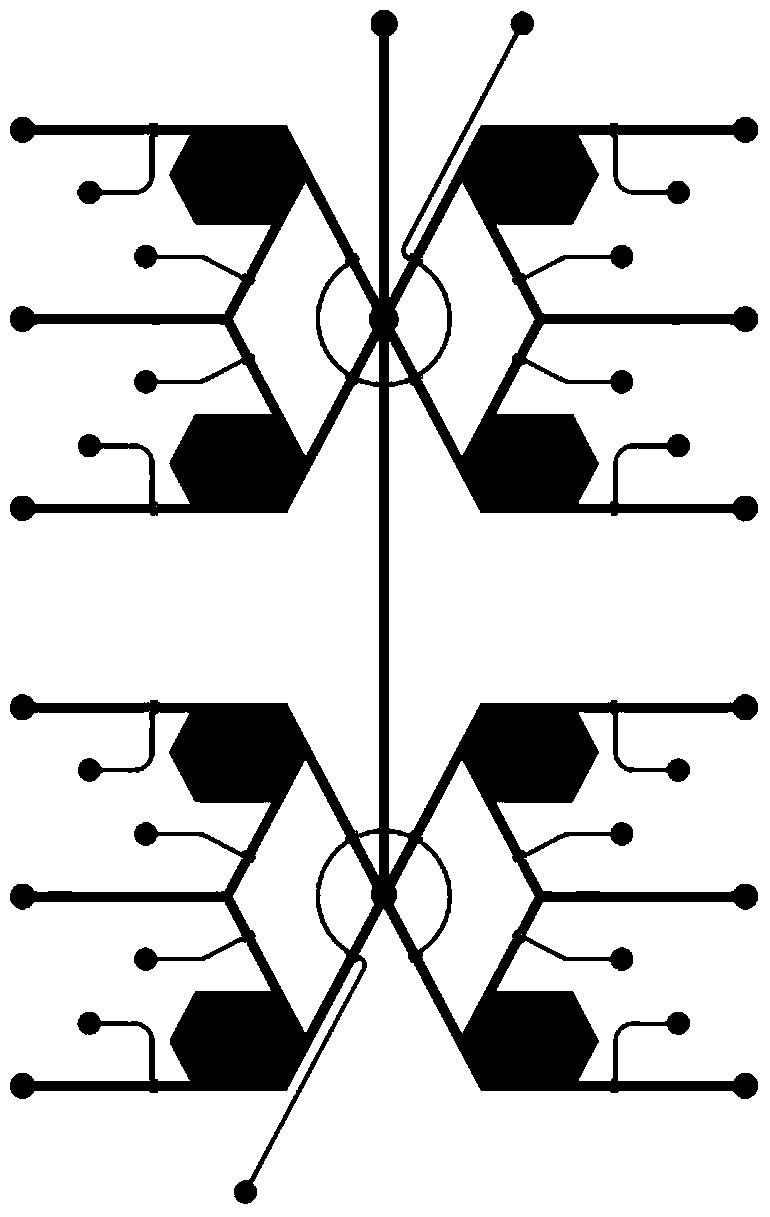A method for detecting serum allergen-specific IGE based on microfluidic chip and protein chip
A protein chip and microfluidic chip technology, applied in the field of biomedicine, can solve the problems of immune response, failure to reach blood volume, limited blood volume, etc., to reduce usage, suitable for large-scale epidemiological analysis, and reduce usage The effect of volume and detection time
- Summary
- Abstract
- Description
- Claims
- Application Information
AI Technical Summary
Problems solved by technology
Method used
Image
Examples
Embodiment 1
[0041] Example 1 Preparation of protein chip
[0042] (1) Recombinant antigen (rDerf 2 , rBt5, rRcla, rPlaa1, rHumj, a group of negative BSA) diluted into 4 gradients, respectively 1.5mg / ml, 1mg / ml, 0.4mg / ml, 0.04mg / ml. Added 25% of Glycerol, take 40ul of each diluted sample into a 384-well plate, and centrifuge at 4000 rpm for 1min;
[0043] (2) Spotting with a spotting machine, spotting on a solid phase (glass) protein carrier, and repeating spotting 3 times for each sample;
[0044] (3) After spotting the samples, put them in the refrigerator at 4°C overnight, and store them at -80°C the next day for later use.
Embodiment 2
[0045] Example 2 Preparation of microfluidic chip
[0046] (1) Substrate preparation: Put the silicon wafer into Piranha solution (98% concentrated sulfuric acid: 30% hydrogen peroxide = 7:3) and boil for 15 minutes; rinse with deionized water, blow dry with nitrogen, and bake at 200°C for 30 minutes; Pour AZ-50XT glue (Microchem Company) on the center of the silicon wafer; use a glue spreader to spin coat at 3000 rpm for 1 minute to make the glue evenly distributed, let it stand for 10 minutes, and then dry it softly on a constant temperature heating plate. Place at 65°C, 95°C, and 65°C for 3 minutes, 6 minutes, and 3 minutes, respectively;
[0047] (2) Exposure: Place the designed silicon wafer templates of the fluid layer and the valve control layer on the baked substrate, expose them with a UV exposure machine, and then place them on a heating plate for baking;
[0048] (3) Developing: Put the silicon wafer into the developing solution for developing, and the developing i...
Embodiment 3
[0053] Example 3 Serological detection of allergic patients based on microfluidic chip
[0054] The bonded microfluidic chip and protein chip were blocked with PBS containing 3% BSA for 1 hour, and 1 μl (1:35 dilution) of serum from an allergic patient was pumped into the reaction chamber of the microfluidic chip, and fixed on the solid phase glass carrier. The allergen will bind to the specific IgE antibody in the serum. After washing with PBS, add 1 μl of goat anti-human IgE antibody (1:300 dilution) and incubate for 1 hour, then wash with PBS, add cy3-labeled donkey anti-goat antibody for incubation ( 1:1000 dilution) for 1 hour, after washing with PBS, the microfluidic chip and the protein chip were separated, and the protein chip was placed on the chip scanner to collect fluorescence signals for data analysis; one microfluidic chip can detect eight serums at the same time , the hardware part of the entire detection system is mainly the control part and data analysis (comp...
PUM
 Login to View More
Login to View More Abstract
Description
Claims
Application Information
 Login to View More
Login to View More - R&D
- Intellectual Property
- Life Sciences
- Materials
- Tech Scout
- Unparalleled Data Quality
- Higher Quality Content
- 60% Fewer Hallucinations
Browse by: Latest US Patents, China's latest patents, Technical Efficacy Thesaurus, Application Domain, Technology Topic, Popular Technical Reports.
© 2025 PatSnap. All rights reserved.Legal|Privacy policy|Modern Slavery Act Transparency Statement|Sitemap|About US| Contact US: help@patsnap.com



